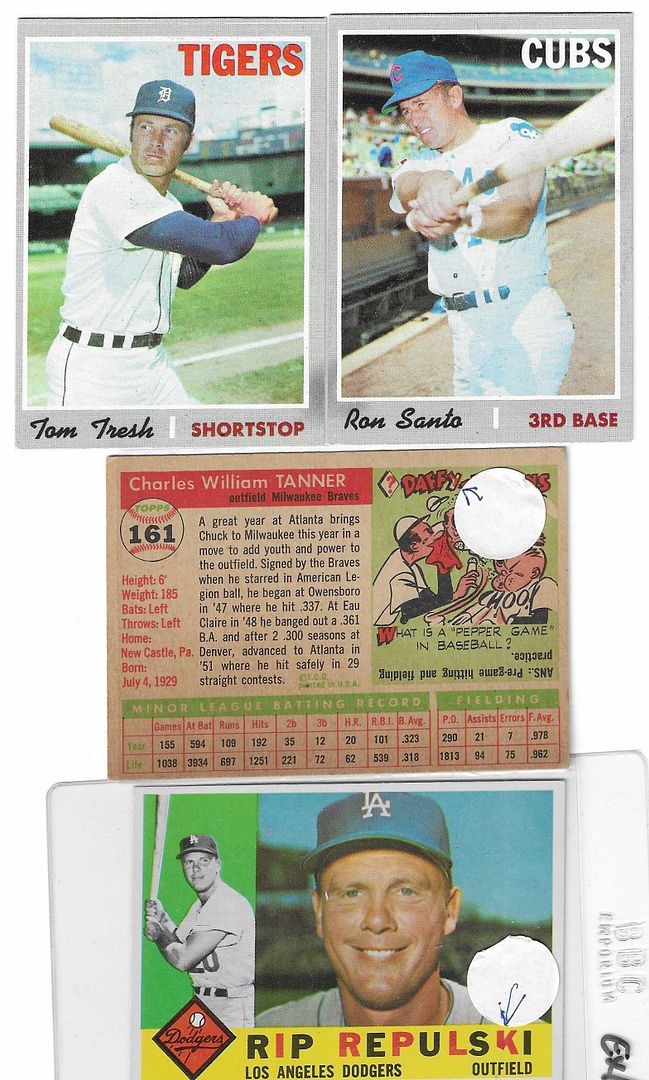|
|
|
|
#1
|
|||
|
|||
|
Quote:
Seems odd they would not just cover up the spot with white ink, instead of the yellowish greenish goldish color. Can't really think of another good explanation for it than what you propose. |
|
#2
|
|||
|
|||
|
Quote:
If the defect is on both the blue plate and the yellow plate, that means it's from somewhere in the process of making the plates. And one that ended up on the mask for both colors. If you redo the image to fix the blue mask, but not the yellow, the blue dot will go away, but you'll still have the yellow one. Which they may or may not have corrected since it's not as obvious, and the color separations were relatively expensive at the time. |
|
#3
|
|||
|
|||
|
Quote:
|
|
#4
|
|||
|
|||
|
Following up to #1929 with John's Nobis cards, looks like it comes in a second variation where only the white in his name is impacted, and the club name is correct.
I've found a roughly even number of both versions of the misprint. |
|
#5
|
|||
|
|||
|
Those Nobis cards are some of the more interesting printing problems I've seen.
|
|
#6
|
|||
|
|||
|
Some recent pick ups based on prior posts by others

|
|
#7
|
|||
|
|||
|
Hi Gang:
Just picked up a big group of 60 Topps proofs/variations. Here are a few Issued cards to the left. Photo 1 note the color background on the small inset photo to the left Second photo top three cards note the the photo on the inset photo extends over the border, the last card, Gonzalez note the blue bottom border extends over logo
__________________
Fr3d mcKi3 Last edited by whiteymet; 01-25-2022 at 05:53 PM. |
|
#8
|
|||
|
|||
|
Quote:
The way the printed areas are made in a brief step by step Original art/photos created Color separations done, photographing the original through a filter to produce blue, magenta, yellow and black halftones. (On some cards, there are non- halftone areas like borders.) Those generate large negatives known as the mask. That is used to expose the plate which gets developed. On the press, the plate gets wet, then inked with oil based ink. That transfers to the "mat" which is a rubber roller (sort of) Then transfers to the paper. Yellow is usually printed first, followed by ... I forget if blue or magenta is next, then finally black (And glosscoat if you're making it at all glossy.) There may be days between colors on a really big job unless a multi color press is used or multiple presses. If there's a big colored spot, the two fixes are either making a new mask without the spot. Or stoning off the spot on one of the darker colors, if you notice it early enough. Color separations cost a LOT at the time, I wasn't involved in the pricing, but I think the place I worked got a couple hundred even on a small job in 1980-81 Stoning off the spot in the blue plate would give a yellowish spot since yellow would already be there. And you'd probably have to do it for red too if it was there. A spot caused by debris could be on all 4 colors, or just on one. |
 |
|
|
 Similar Threads
Similar Threads
|
||||
| Thread | Thread Starter | Forum | Replies | Last Post |
| 1966 Topps High # Print Variations | 4reals | Postwar Baseball Cards Forum (Pre-1980) | 9 | 04-27-2014 07:05 PM |
| Are these variations or print defects? | savedfrommyspokes | Postwar Baseball Cards Forum (Pre-1980) | 16 | 02-09-2013 12:52 PM |
| Well known print defects. Do variations exist without? | novakjr | Postwar Baseball Cards Forum (Pre-1980) | 9 | 01-28-2011 05:32 PM |
| Finally confirmed - d311 print variations exist! ("bluegrass" variations) | shammus | Net54baseball Vintage (WWII & Older) Baseball Cards & New Member Introductions | 8 | 09-03-2010 08:58 PM |
| Wanted: T206 Print Variations and Errors | Archive | Tobacco (T) cards, except T206 B/S/T | 1 | 01-04-2007 08:23 PM |